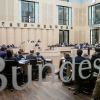The German parliament and the parties
The German Bundestag is elected every four years by free, secret, and direct ballot by citizens aged 18 and over who are eligible to vote.

The Bundestag is the German parliament. Half of the 630 seats in the Bundestag are allocated through the election of candidates put up by the parties on state lists (second votes), the other half through the election of persons in 299 constituencies (first votes). The German electoral system makes it difficult for any one party to form a government on its own – meaning that a coalition tends to be the rule. In order to prevent complications in the formation of majorities by the presence of small and very small parties, a threshold known as “the five percent hurdle” excludes parties that poll less than five percent being represented in the Bundestag.
Six parties with 630 members of parliament are represented in the 21th German Bundestag: SPD, CDU, CSU, Alliance 90/The Greens, AfD and The Left. Ever since the first Bundestag election in 1949, the CDU and its sister party CSU, which only stands in Bavaria, have formed a single parliamentary party.
